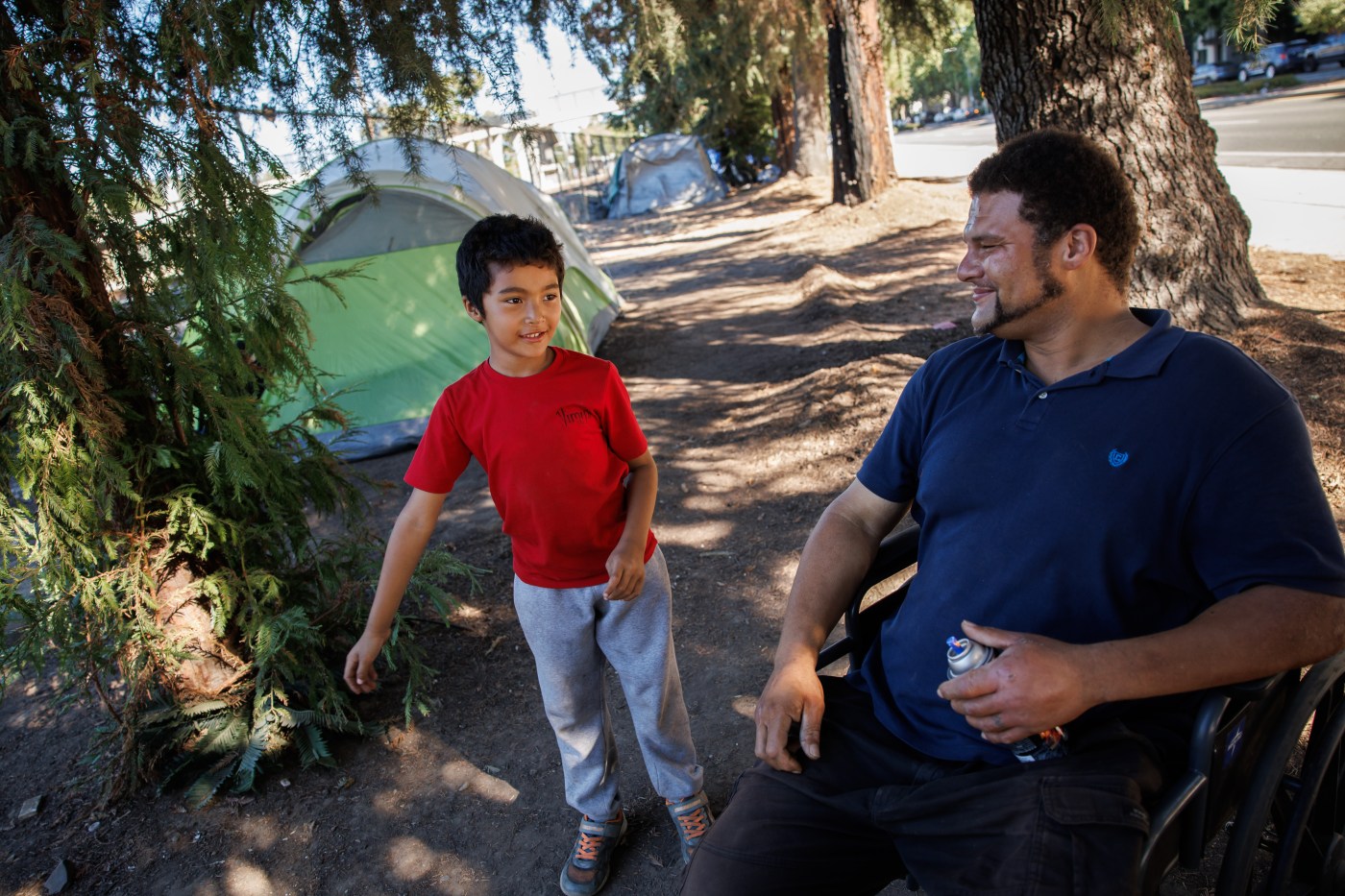Each morning before school, Dimmi wakes up in a green tent by the railroad tracks that bisect South San Jose. The 7-year-old wriggles out of a lime green sleeping bag, and often reaches for a handful of Goldfish crackers or Utz cheese balls stashed beneath his cot.
His mother, Sammi, helps him pack his gray backpack, and they set out on the half-mile walk to catch a transit bus to school, passing busy commuters lined up at a nearby McDonald’s drive-thru for their morning coffee.
After class lets out, Dimmi and the man he calls Dad, Dameon Wright, often kick around a soccer ball before the family uses food stamps to buy dinner at Taco Bell or a discount supermarket. Then it’s time to go over that evening’s homework and prepare for bed.
Dameon Wright watches Dimmi, 7, swing a golf club near their tent at a homeless encampment in San Jose, Calif., on Wednesday, Aug. 14, 2024. (Dai Sugano/Bay Area News Group)
But since finding himself living in an encampment almost three weeks ago, Dimmi rarely sleeps through the night. Freight trains rumble past at all hours, while strangers sometimes peer into the tent he shares with his mother.
He misses the simple comforts of having a home: sleeping on a mattress, eating hot food from a microwave, the privacy of a bathroom.
“It’s cold,” said Dimmi, a wiry second-grader with tousled brown hair. “And I have no shower.”
In 2023, Santa Clara County counted 211 homeless children under the age of 18 living without shelter, up from 112 the year before. Last year’s count was less than a third of the 664 unsheltered children counted in 2017, four years before the county created a campaign to end family homelessness.
Statewide, unsheltered children, both unaccompanied and with families, make up 2% of the total homeless population of more than 181,000 people. The consequences for the thousands of children living on the street across California are especially grave. Researchers have found that children without stable housing or shelter are more likely to have physical and behavioral health issues, be separated from their families and struggle at school or drop out altogether, according to the National Alliance to End Homelessness.
In an effort to bring all homeless families indoors, local officials and nonprofits have added hundreds of family shelter beds, tiny homes, converted motel rooms and supportive housing units in recent years, helping to permanently house more than 1,700 homeless families since 2021.
Yet the ultimate goal of having no families with children sleeping on the street remains elusive. There are still simply not enough beds for everyone who needs them.
“We aren’t able to keep up with those ever-persistent economic demands and the local lack of affordable housing that pushes people into homelessness every day,” said Kathryn Kaminski, the county’s acting top homelessness official.
It’s unclear why Dimmi’s family has been unable to secure shelter or housing. Wright and a local homeless advocate named Gail Osmer said they have contacted the city of San Jose and one of its homeless service providers about the family’s situation. Wright said he rejected an offer to go to a shelter by himself, not wanting to leave Dimmi and his mother behind. Wright said he intends to sign up for a waitlist for a family shelter.
Wright, 46, who lost his lower left leg in a motorcycle accident, said finding employment is impossible. It’s especially challenging with his criminal record.
“Being out here in the elements is kind of just uncalled for. I’ve been patient. I can’t work,” he said. “I’ve tried working. There’s only so much I can do.”
Dameon Wright talks about living in a homeless encampment with Dimmi and his mother, Sammi, in San Jose, Calif., on Wednesday, Aug. 14, 2024. (Dai Sugano/Bay Area News Group)
Officials with San Jose’s housing department and its nonprofit provider, HomeFirst, said they do not comment on homeless families’ individual circumstances. In a statement, HomeFirst said, “we recognize that each family and every person has their own unique journey out of homelessness, and we strive to meet people where they are.”
Wright said Dimmi and Sammi, who struggles with severe mental health challenges, lost the room they were renting a few months ago after she was fired from a fast food job. They moved into her car, but it was totaled after catching fire. After a subsequent car was towed, the pair were left with nowhere else to go.
When Wright, who was already living on the street, learned about the situation, he rushed to move them to the small, well-kept encampment where they now all stay. The family lives beside at least a dozen unhoused adults spread out along a pine tree-shaded median between the rail line and a busy roadway.
Dimmi “really needs me more than anything,” Wright said. “He needs her, too.”
Both Wright and Sammi, who are not married and do not share the same last name, have mental health issues and a history with the criminal justice system and child protective services, according to court records.
Related Articles
San Jose neighbors’ backlash delays plan to use tiny homes for jail diversion
Letters: E-bike distinctions | Protecting jobs | Victorville lessons | Death penalty | Misleading assertions
Alameda County awarded $14 million to address intersection of mental health and homelessness
Letters: Child care | Embracing court | Democrats’ echo
Letters: BART accountability | Cruelty no answer | Not ousted | Cancel Trump | Gaza’s suffering
Wright said he spent the first five years of Dimmi’s life in prison stemming from robbery cases. He was also convicted of multiple misdemeanor domestic violence charges, the latest charge coming in 2017, against former partners, not including Sammi. Wright said he’s since learned to “de-escalate” arguments and heated discussions.
When Dimmi was a toddler, Sammi lost custody of him for at least six months when she was convicted of misdemeanor child endangerment and being under the influence of methamphetamine in 2019. Social workers later that year recommended the county return Dimmi to his mother as long as she agreed to parenting classes and other conditions. She was not required to provide housing.
The county’s social services department declined to discuss the details of Sammi’s case. After reuniting a child and parent, a judge decides what level of engagement the department should have with the family. Social workers develop a case plan that may include parenting classes, substance abuse treatment, mental health counseling and connection to housing services.
Under state law, the fact that a child is homeless is not, on its own, reason enough for social services to take them from a parent, officials said.
Dimmi is reluctant to say that he’s homeless, but it’s clear he understands his situation.
“Your credit card doesn’t have any money,” he told Wright on a recent afternoon at the camp. “You’re broker than Donald Trump!”
“That’s pretty broke,” Wright replied, laughing.
Still, there are moments of joy at the encampment. As the family was getting ready to head to a nearby park, a friend of Wright’s approached with a gift for Dimmi: a black and red BMX bike that had once belonged to his son.
Dimmi’s face lit up.
“Dang, this is sick!” he crowed. He hopped on, cruising back and forth along the sidewalk, Wright trailing not far behind.
Unhoused resident Dameon Wright helps Dimmi, 7, ride his bicycle at a homeless encampment, where they are currently living in San Jose, Calif., on Wednesday, Aug. 14, 2024. (Dai Sugano/Bay Area News Group)
Editor’s note: The Bay Area News Group is not identifying the child and his mother, who share a last name, in this story because he is a minor and to protect them from further risk as a homeless family.












